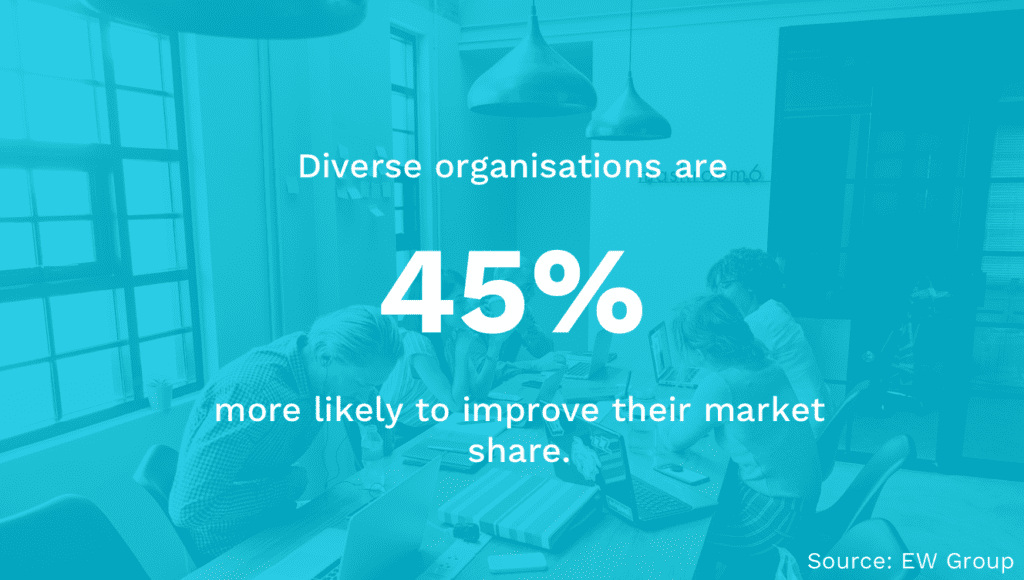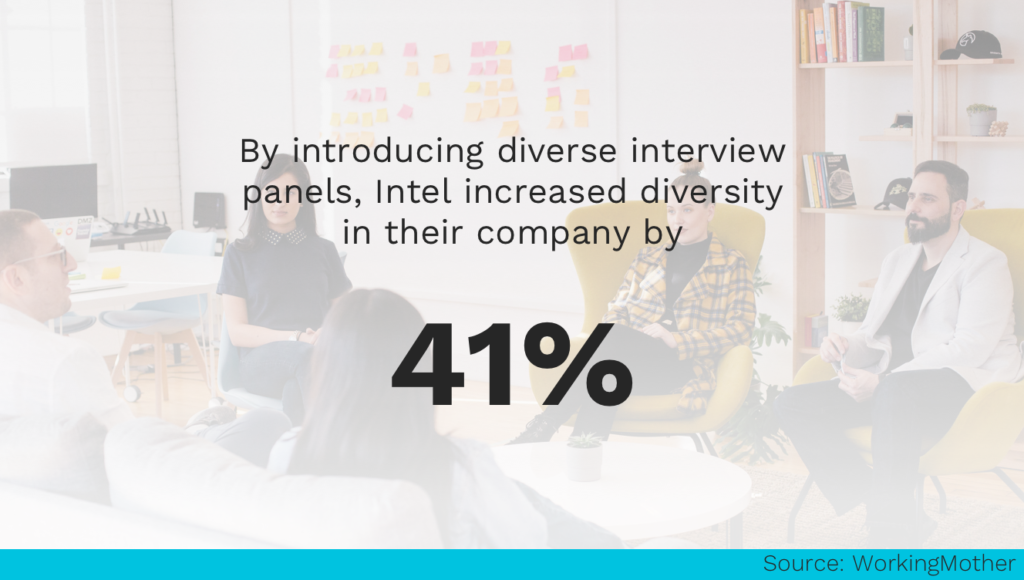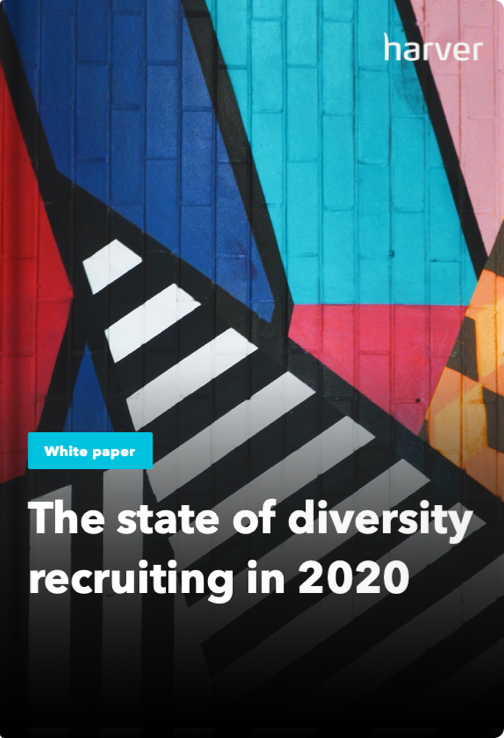As recruiters, we often talk about diversity and building inclusive teams. A diverse team brings a unique set of opinions and perspectives to your company. In fact, companies with diverse workforces typically outperform their competitors and report having happier employees.
However, despite the hype, only about half of employers actually have programs in place to attract diverse candidates. About the same number do not monitor employee diversity.
Unfortunately, bias––even if it is subconscious––can prevent diversity from occurring naturally in some organizations. To create inclusive teams, it’s important for your recruiters to have set programs that help encourage more diverse hires.
Practicing inclusive recruitment can help your team grow efficiently, create happier employees, build strong teams, and help your organization beat out your competitors. Here are a few inclusive recruitment best practices for your team to adopt.
- Educate your team
- Widen your candidate search
- Choose the right supportive tools
- Build a diverse talent pool
- Involve diverse people in the hiring process
- Bonus tip: Create an inclusive environment
Like what you see?
Don’t miss out. Subscribe to our quarterly digest to get the latest TA and TM resources delivered right to your inbox.
What is inclusive recruitment?
Inclusive recruitment is the process of connecting with, interviewing, and hiring a diverse set of individuals through understanding and valuing different backgrounds and opinions. Inclusive recruiting should be intersectional and consider more than just gender or race.
An inclusive recruiting environment considers how different experiences, opinions, and values can work together to achieve a common goal. By creating a diverse workforce, your teams are pushed to think outside their comfort zone and challenge new thoughts or ideas.

…and 35% more likely to financially outperform their industry’s national average. If you’re wondering why you should care about inclusivity at your company, think about the bottom line.
Proven inclusive recruitment best practices
Sometimes, creating a diverse team can be a challenge. If your recruiters aren’t paying close attention, they may naturally gravitate towards candidates that they connect with on a personal level or those that look like the employees already in the office.
Creating inclusive recruitment practices can prevent your recruiters from functioning in auto-pilot and make them put more effort into building a diverse workforce. To improve your recruitment processes to be more inclusive, here are a few best practices you should consider.
Hear our 5 Proven Practices For A More Inclusive Recruitment
on Recruitment On The Go!
1. Educate your team.
Did you know there are at least 13 common hiring biases? The first step in creating a more inclusive recruitment program is to educate your team on what these biases might look like.
A lot of the bias we talk about as recruiters might come down to things like gender, race, or religion. While it’s important to be aware of these kinds of bias, there are many other different forms of bias that may prevent a hiring team from connecting with the right candidates.
For example, a recruiter may experience confirmation bias if they’re quick to make a judgment before getting to know a candidate. To confirm their original assumptions were correct, they’ll look for any responses or behaviors that reinforce their initial opinion––even if it means overlooking some great skills or characteristics that would make the candidate a great match for the job.
To reduce this kind of bias, as well as any others that might make their way into your recruitment process, you need to provide proper education and training to your teams. However, extend this learning opportunity beyond just recruitment and HR. Talk to your various teams and departments about the importance of an inclusive environment.
Diversity and education training should be an ongoing process, not something you complete once to check a box. Create a recurring education program that helps your teams identify and eliminate unconscious bias.

Applicants from underrepresented groups often resort to “whitening” their resumes to get more job interviews. Moreover, 2/3 know someone who had done so. This is a result of poor inclusive recruitment practices across companies.
2. Widen your candidate search.
If you find that your candidate pool is comprised of individuals with similar educations, backgrounds, and experience levels, your search may be too narrow. After all, similar people tend to use the same channels to apply to jobs.
While it’s good to know how to connect with the individuals you want to apply to your open positions, sometimes you can restrict your candidate pool too much. In order to open it back up and get some more diverse applicants, get creative about where you advertise your openings.
Let’s say you’re hiring a group of entry-level employees. In the past, you’ve always connected with prospects at college and university job fairs. While you’ve hired some great candidates in the past, they all fall within the same box.
You can expand your candidate search by looking for candidates at different schools. Connect with students at universities in different areas, or those who come from different backgrounds and education levels.
Another way to expand your candidate search is to post on different job boards or to use social media to try and attract talent. By switching up the way you’ve always done things, you can connect with applicants who may have overlooked your open job position in the past.
3. Choose the right supportive tools.
It can be incredibly difficult for humans to completely eliminate bias, particularly if it is subconscious. This is where having the right supportive tools, including AI recruitment tools, can come into play.
An AI recruitment tool can look at your candidates objectively to help determine which individual is right for your open position. However, AI is not automatically free from bias. In fact, one major e-commerce company had to scrap their AI recruitment tool because it was showing bias towards women.
A whopping 45% of employers believe the recruitment tools they’re using are ineffective at helping diverse candidates find their company. It’s crucial for your organization that you choose a tool that provides you with the processes and systems you need to create an inclusive recruitment process.
One way to ensure your AI recruitment tool encourages diverse workplaces is through providing custom options. When your team is able to adjust the tool to fit your unique and specific needs, you can build a job application process that encourages inclusivity and diversity.
You also want to be sure your tool is checked regularly for human bias. Although AI does power the tool, human error can still influence the way AI ‘thinks’. Consistent check-ups can identify and remove any bias before it impacts your recruitment process.

The company was also able to attract more female candidates to apply.
4. Build a diverse talent pool.
When you’re hiring for an open position, you likely have a set of qualifications you’ll want to see in each applicant. While having some guidelines can be helpful, if you’re sticking to them too strictly, you may actually be hurting your chances of finding a great hire.
For example, let’s say you’re looking for five years of relevant experience for an open position. Each candidate that has less than five years of experience is automatically removed from your talent pool. While this ensures you hire an individual with the pre-determined level of experience you were looking for, it also cuts out candidates who may be just what you’re looking for with only three or four years of experience.
Building a diverse talent pool allows you to see different perspectives, as well as recognize that experience can come outside of the workforce. Diverse qualifications can also add something new and exciting to your team, encouraging everyone in the department to think differently.
When building your talent pool, take a look at who you’re connecting with and what kinds of individuals are missing. If you see that a particular group is not applying to your open positions, you’ll want to develop a strategy for connecting. Discover where they’re looking for jobs, what kinds of jobs they might be interested in, and what you can provide that might encourage them to apply.
Keeping a diverse talent pool on file can also making hiring easier. If someone isn’t the right fit for a particular job but still fits within your company’s needs and culture, keeping their information handy for a relevant open position can make your job easier in the future.
The state of diversity recruiting in 2020
5. Involve diverse people in the hiring process.
In order to create a diverse workplace, it needs to be run by diverse people. When you have a number of different individuals following along in the hiring process, you can get feedback, perspectives, and opinions from people with different needs and expectations.
The hiring process should be collaborative––including those beyond just your recruitment and hiring team. Reaching out to other departments, team members, and company leaders can remove bias by taking different perspectives into account.
When hiring feels like a group decision, you’re more likely to get an individual who doesn’t fit a particular mold.
However, a diverse group of people should be involved in every step of the way, not just when you’re ready to extend an offer. You’ll at least want a second set of eyeballs on resumes and sitting in on interviews to get another opinion on each candidate.
A diverse work team can also encourage more diversity. When candidates go through the interview process and engage with many different kinds of people, it can be encouraging for them to come work at your organization.
Look for ways to bring diverse team members into your hiring process. Ask for opinions and feedback from many different individuals and use their unique experiences to create an inclusive environment for new people. Continuously reconnect with team members to further refine your process and bring new individuals into the hiring process.

The panel of interviewers for any new hire had to include at least two women and/or members of underrepresented minorities. The company was able to hire significantly more women and people of color than previously.
Bonus tip: Create an inclusive environment
An inclusive hiring process is just the first step. If you only focus on building an inclusive hiring process but ignore your company culture, employees who don’t fit a homogenous mold will be unhappy when they get into their new positions.
To encourage them to stick around––and to truly enjoy their time at your company––you need to create an inclusive work environment.
An inclusive workplace culture gives each employee a unique voice and encourages them to be themselves. Their individual needs are not only met, but they’re encouraged to take time for personal responsibilities that they believe are important.
You can’t force an inclusive environment. However, talking with your employees to discover ways you can make your office more open to diversity can go a long way. Holding trainings, seminars, and events that help educate employees on the importance of diversity can also create a more inclusive environment.
To conclude
Diversity shouldn’t be treated as just another box you check. When you have a team of employees with different experience levels, backgrounds, and educations, you can bring a mix of different thoughts, opinions, and ideas to the table. With a more creative thinking pool, you can stick out from your competition and create better products or services.
However, a diverse team doesn’t happen overnight. You need to put the right processes and systems in place to create an inclusive recruitment team.
These five best practices (plus the bonus tip) should be just the starting point for your inclusive recruitment process. While they are a great place to jump off from, you’ll want to listen to what your applicants and job candidates are telling you.
Pay close attention to who is applying to your open positions. Don’t be afraid to mix things up and try something new. As you continue to refine your process to fit the needs of different groups and individuals, you can start seeing more diverse applicants and start hiring a more inclusive group of team members.
The state of diversity recruiting in 2020



